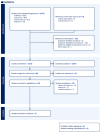Reduced Versus Full-Dose Direct Oral Anticoagulants for Venous Thromboembolism in Cancer Patients: A Systematic Review and Meta-Analysis
- PMID: 41000253
- PMCID: PMC12459301
- DOI: 10.1002/jha2.70155
Reduced Versus Full-Dose Direct Oral Anticoagulants for Venous Thromboembolism in Cancer Patients: A Systematic Review and Meta-Analysis
Abstract
Background: Venous thromboembolism (VTE) is a serious complication in cancer patients, with malignancy increasing the risk significantly. Direct oral anticoagulants (DOACs) have emerged as a convenient alternative to traditional therapies, though optimal dosing remains uncertain.
Methods: We performed a systematic review and meta-analysis on three studies. A comprehensive literature search was performed on PubMed, Embase, the Cochrane Library, and ScienceDirect till April 2025. Analysis was carried out on RevMan 5.4. The risk of bias was assessed via RoB 2.0.
Results: A total of three studies with 2416 participants were identified, including 1495 patients in the reduced-dose group and 1232 patients in the full-dose group. No significant difference was observed in recurrent VTE (OR 0.70, 95% CI 0.45-1.09, p = 0.11) or recurrent symptomatic VTE (OR 0.96, 95% CI 0.50-1.84, p = 0.91). However, reduced-dose DOACs were associated with a significantly lower incidence of incidental VTE (OR 0.31, 95% CI 0.14-0.69, p = 0.004). The reduced-dose group also had a lower incidence of CRNMB plus major bleeding (OR 0.69, 95% CI 0.55-0.88, p = 0.002).
Conclusions: In terms of venous thromboembolism, bleeding events, and all-cause mortality, reduced-dose DOACs demonstrated a safety profile that was either superior or comparable to that of full-dose DOACs.
Trial registration: The authors have confirmed clinical trial registration is not needed for this submission.
© 2025 The Author(s). eJHaem published by British Society for Haematology and John Wiley & Sons Ltd.
Conflict of interest statement
The authors declare no conflicts of interest.
Figures






References
-
- Lee A. Y. Y. and Levine M. N., “Venous Thromboembolism and Cancer: Risks and Outcomes,” Circulation 107 (2003): I–17. - PubMed
-
- Baron J. A., Gridley G., Weiderpass E., Nyren O., and Linet M., “Venous Thromboembolism and Cancer,” Lancet 351, no. 9109 (1998): 1077–1080. - PubMed
-
- Dong Y., Wang Y., Ma R.‐L., et al., “Efficacy and Safety of Direct Oral Anticoagulants Versus Low‐Molecular‐Weight Heparin in Patients With Cancer: A Systematic Review and Meta‐Analysis,” Journal of Thrombosis and Thrombolysis 48, no. 3 (2019): 400–412. - PubMed
Publication types
LinkOut - more resources
Full Text Sources
Miscellaneous
